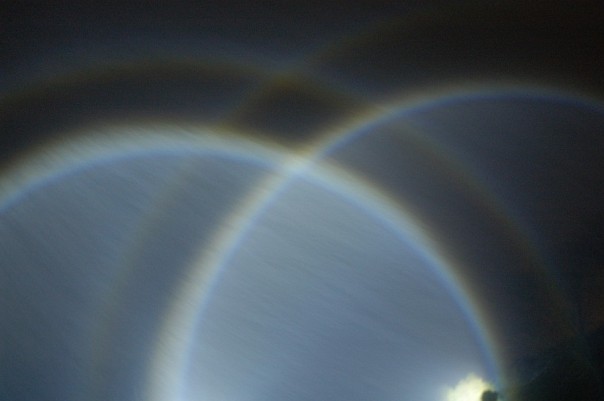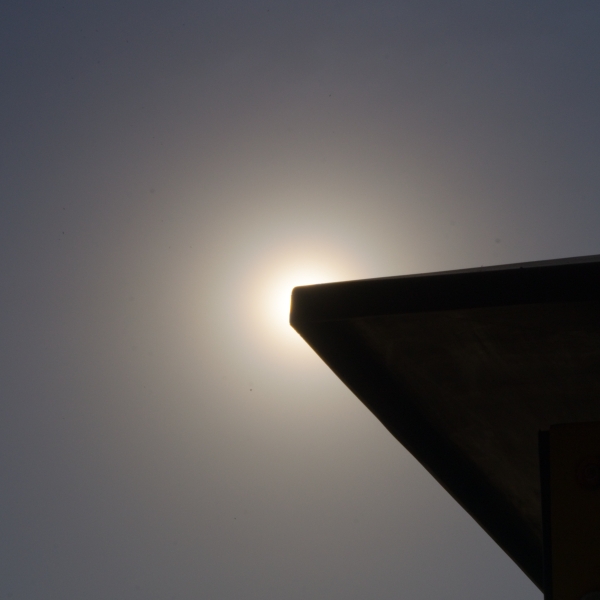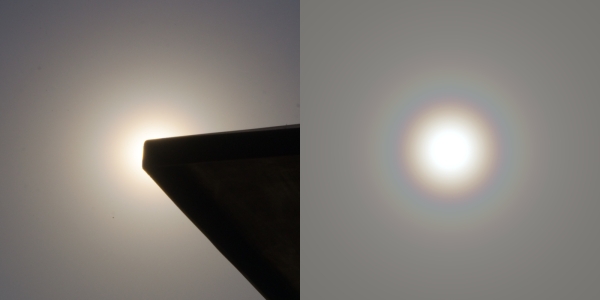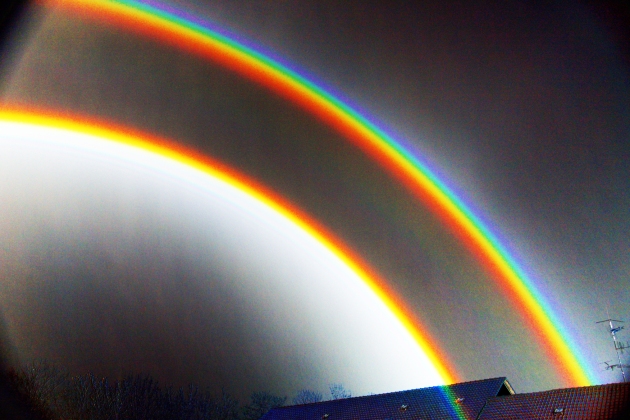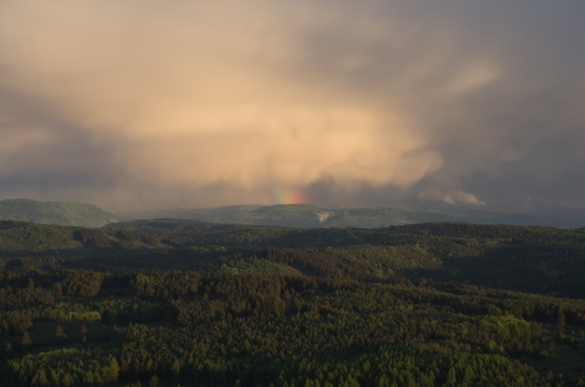Binary double rainbows
In past years I have done spot light rainbows when the rain was a fine mist. After seeing the results of a nice fog bow my LED flashlight made and since I had two I thought why don’t I try doing two at once. So I turned both lights on the hi-power mode which yielded a very bright beam of light and both lights were placed on fence posts 2 meters apart. I angled the lights so the beams crossed and at the point where they crossed is where I placed the camera. I took a shot was blown away by the results! There it was two full circle double rainbows crossing one another. I took quite a few shots before I was getting chill and wet. Just think if you landed on an Earth like exo-planet orbiting a binary star system and upon exiting your space craft you look up and see twin suns shining above then you hear a rumble of thunder. You retreat into your ship for shelter and later the storm moves on but its still raining but you look on the opposite side of the sky and see two double rainbows displaced a few degrees apart and the bows would cross one another. These flashlight binary double rainbows show how rainbows would look to civilizations living on Earth like Exo-planets orbiting double, triple, or even quadruple star systems. Next time I will use 3 and 4 LED flashlights. On the nights I was doing these bows the wind was blowing and I could see the primary bow in particular would move from side to side and one pic even shows that it could be twinned!!!
Author: Michael Ellestad, USA
Commonly spread Ice Wool
On February 2nd, 2016, we made an excursion to the Anna Tower together with my daughter´s form. The Anna Tower is located in the Deister hills, a small range of hills at about 20 kilometres southwest of Hanover. Its highest elevation ist Mt Bröhn near the Anna Tower with about 405 metres above sea level. We startet from the Nienstädter Pass at 277 metres above sea level. The car park there is covered with gravel and normally rather muddy, but that day it was frozen and hoar frost glittered everywhere. When we startet our excursion, the weather was bright and sunny. But as soon as we left the car park, I noticed a fibrous thing of brilliant white just beside the path which leads along the top of the range. At first sight, it looked like a sheared piece of wool from a sheep. But for me it was clear what it was: ice wool!
Up to then, I knew ice wool only from descriptions, and although I had been looking for it for years everytimes there was a light frost, I never found some. And now I found it right beside the path, without having searched for it! After having given others a hint on that phenomenon and explaining it, I took some photographs and then continued my way – slowly and even slower, because there were more and more tree branches which showed ice wool. After having found 10 of these ice wool formations, I roughly counted them, but when I reached 50, I stopped counting. It made no sense, because there was too much. I found a place where at least 20 branches and twigs with ice wool laid around. Not every ice wool formation was well defined, but there were also some very bizarre ones among them!
I arrived at the Anna Tower about one hour delayed. The weather was nice, but it was not really clear. There was a distinct inversion with a pronounced layer of mist, but without any mirages. I think, for this the hill is not high enough. (At really clear conditions you can see Mt Brocken in the east and the Porta Westfalica in the west from the Anna Tower).
Three weeks later, on February 27, I succeeded in finding ice wool at the Nienstädter Pass again. This time I was prepared better and brought a retro adapter to make macro photographs. Thus it was possible to take detailed pictures of the ice wool. Some parts of it had structures which reminded of chains of bacilli. Other parts just looked like shiny and transparent hair. The augmentation effect of the lens with retro adapter was not strong enough to unravel the structures here.
- Modified by CombineZP
- Modified by CombineZP
Background information:
Ice wool is a physical and biological phenomenon which mainly appears on rotten and decayed wood in deciduous forest with mixed types of trees. It forms hairy ice curls of a brilliant white which remind of candyfloss. Sometimes it looks like paintbrushs with the uppermost parts cut away, others look like wool from a sheep, others remind of minerals or lichen. And sometimes it looks just like a thrown away paper tissue and is often mixed up with this from the distance. But it has always this hairy and cristalline structure which sometimes looks like chains or if it was covered with sugar.
Ice wool is caused by the activity of funguses which decompose rotten wood. During this process, water is set free which gets out of the dead wood through capillaries and freezes at temperatures around or slightly below 0 °C, forming these hairy ice structures. This works as long as the wood itself does not freeze. Contrary to hoar frost crystals, ice wool is formed by liquid water from the wood freezing outside while the atmosphere is not involved. It is not long ago that the process could really be clarified.
Ideal conditions for the formation of ice wool are given when after a period of mild weather with (light) rain the sky clears off at night allowing frost on the ground. So, when you have to scratch the ice off your car windows, there is also a chance of encountering ice wool in the forests. It can be found from October until the beginning of March, except during very cold periods. Best places to find ice wool are under oak and beech trees and maybe also under some larches. Other conifers are not suitable.
But you also need some good luck when looking for ice wool, just as it normally is not wide spread. Similar to the appearing of mushrooms and toadstools, there seem to be good and bad years. Even if the conditions may apparently be perfect, you will not automatically find ice wool. Locations also seem to play an important role as I could see for myself a short time ago. While ice wool was rather abundant up there along the path on the top of the range, I could not find any of it in the Deister forest near my home, although the tree population there is not very different from that at the Nienstädter Pass. Also here lots of branches and twigs in all stages of rotting are lying around, but there is not a single trace of ice wool to be found.
Author: Reinhard Nitze, Barsinghausen, Germany
Olea europaea pollen corona
During the days of the 12th Light & Color in nature meeting (May 31st-June 3rd, 2016) in Granada, Spain, I noticed almost constantly a diffuse aureole around the sun, appearing against the background of a clear sky:

previous picture unsharp masked
All photos were cropped to a common viewing angle of 15° x 15° and the color saturation was increased.
Because of the dry and often cloudless summer weather we had back then, it seems unlikely that any kind of water drops did cause the phenomenon. On the other hand, the angular radius was way too small for Bishop’s ring, which at first seemed to be a plausible option as we had observed some haze towards Africa shortly before our plane landed in Malaga on May 30th.
No pronounced color pattern was visible to the naked eye, nor through a gray filter, but the saturation increase in the image processing revealed a typical corona structure with alternating colors. Thinking of pollen as possible scattering particles, the large amount of olive trees (olea europaea) in Andalusia immediately comes to mind. Furthermore, we witnessed ourselves that the olive trees were blooming these days when we visited a grove at Monachil in the vicinity of Granada – some of the visitors’ shirts or backpacks got covered with green dust after coming too close to the trees.

The olive grove at Monachil with the Sierra Nevada in the background (June 2nd, 2016)

A blooming olive twig from a tree in this grove (June 2nd, 2016, photographed by Hironobu Iwabuchi)
In order to check this hypothesis I looked up the shape and size of olive pollen: They are almost spherical with a mean polar diameter of 20.1 µm and mean equatorial diameter of 21.5 µm. For most of the observations, the sun elevation was high enough to simply approximate the pollen as spheres of 21.5 µm in size. I calculated the resulting corona from the solar spectrum using simple diffraction theory (which at this particle sizes is justified):
Both the photograph and the simulation (right hand side) were cropped to a field of view of 10° x 10°. For the simulation, I assumed a relative spread in the pollen size (standard deviation of a Gaussian distribution divided by the mean diameter) of 15%, convoluted the result with the sun’s disk and added a gray background. It matches the photograph quite well, though the contrast of the natural corona remains lower than that of the simulation. Maybe there were other scattering particles with a broader size distribution present, which added another, rather colorless aureole “layer” on top of the pollen corona, thereby diminishing its contrast. Surprisingly, I could not find any previous reports about “olive pollen coronae”, though the phenomenon should be quite prominent during the right season in the olive-growing regions.
Three possible photographic detections of the natural fifth order rainbow from Germany
In 2014, Harald Edens reported ten cases of photographically detected natural quinary rainbows, recorded during 2009-2013 in New Mexico, USA, at altitudes of 1.8-3.2 km. These and some newer observations can also be found on his website.
So far, no reports from other locations have been published. In the German observers’ network, we analyzed many candidate photographs showing bright primary and secondary rainbows, but from most of them no reliable traces of quinary rainbows could be extracted. Such analyses are not easy, as the quinary signal is weak compared to the neighboring secondary rainbow, and processing methods such as unsharp masking can cause a leakage of colors into Alexander’s dark band. Furthermore, the processing operator will experience disturbing afterimage issues from the intense renditions of the primary and secondary on the screen after a couple of minutes.
Despite these difficulties, we now believe that we have identified three cases of genuine quinary rainbows. In cases 1 and 3, the quinary could be extracted from several photographs. Nonetheless, in order to keep this blogpost brief, we restricted ourselves to show only one image (or the results from one polarization series in case 1) per observation. We chose a straightforward processing method (= only increasing contrast and saturation, no local filtering such as unsharp masks) similar to the one applied by Harald Edens to allow for an easier comparison with his results. Alternative processing routes will be presented at a later stage.
1) April 22nd, 2012, near Göttingen, Germany (51° 31’ N, 9° 58’ E, altitude 250 m), 19:16 CEST, sun elevation 10.2°, photographed by Frank Killich after a moderate shower
The original intention of Frank Killich was to use the primary and secondary rainbows as test objects for a home-built photopolarimetric setup made from a Canon 20D camera and a linear polarizer precisely rotatable by a stepper motor. By recording four successive images at polarizer positions of 0°, 45°, 90° and 135° with respect to the vertical, it is possible to reconstruct the first three components of the Stokes vector for each viewing direction (pixel coordinates) and color channel (red, green, blue) individually. These images can be numerically combined to reconstruct the unpolarized intensity (= the ordinary photographic result without a polarizer) and, moreover, the linearly polarized portion of the recorded light distribution (= the total intensity with the unpolarized background removed for each pixel). In the case of rainbows, this corresponds effectively to a subtraction of the radial (weak) component from the azimuthal (strong) polarization component equally all along the visible part of the circumference. As known from theory, also the quinary will be easier to detect in such a polarization contrast image.
Unpolarized intensity as calculated from the original images, f = 22 mm:
Unpolarized intensity, increased saturation and contrast:
Linearly polarized portion as calculated from the original images:
Linearly polarized portion, increased saturation and contrast:
The expected broad bands of green and blue are clearly visible in the processed linearly polarized portion picture, and might be slightly visible also in the unpolarized intensity.
The other two photographic observations were carried out without any polarizers, i.e. only the unpolarized intensity information is available in these cases.
2) March 20th, 2013, near Pforzheim, Germany (48° 56’ N, 8° 36’ E, altitude 312 m), 16:21 CET, sun elevation 21.1°, photographed by Michael Großmann after an intense shower
Original (Canon EOS 450D, f = 22 mm):
Increased saturation and contrast:
A slight green/blue hue is visible inside the secondary at and slightly above the horizon.
3) May 15th, 2016, Mt. Zschirnstein, Germany (50° 51’ N, 14° 11’ E, altitude 560 m), 19:57 CEST, sun elevation 6.2°, photographed by Alexander Haußmann after a moderate shower
A description of this observation (without discussing the quinary rainbow) can be found here. The images shown here are cropped from a fisheye photograph.
Original (Pentax K-5, f= 17 mm, cropped):
Increased saturation and contrast:
Again, a slight green/blue hue appears close to the horizon.
At this point it is of course not possible to draw any statistical conclusions about the frequency of detectable quinary rainbows. However, it seems worthwile that every rainbow observer re-examines his photographical treasure trove for previously overlooked rarities, even if no polarizer enhancement was involved during photographing.
Fogbows in Tenerife
11th of May, 2016 Roberto Porto observed in the Teide National Park (Tenerife, Spain) wunderful fogbows in top of a deeper cloud layer. The moderate climate of Tenerife is controlled to a great extent by the tradewinds, whose humidity is condensed principally over the north and northeast of the island, creating cloud banks that range between 600 and 1,800 metres in height. If moves out of the cloud layer as far as you can see the sun, one has with the sun behind the best observing conditions for a fog bow.
As the name might suggest, a fogbow is the name given to a phenomenon created by the same process of refraction and reflection that creates rainbows, but formed instead by the water droplets in fog, mist or cloud, rather than raindrops.
The timelapse video show 3 different fogbows in the sea of clouds of Volcano Teide. The sun low in the horizon produced the beautiful fogbows.
Photo data: Nikon D5300 and Nikon D90 with Nikkor fish eye 10,5 f:2,8 and tamrom 18-200mm
Unpaired reflection rainbow
The ever growing number of webcams is worth to be checked for both common and rare atmospheric optics phenomena, e.g., like in the case of these twinned rainbow, rainbow at high and low sun (1–2–3–4), red rainbows (1–2–3–4) or moonbows (1–2–3–4).
The Swiss webcam located in Cully at the North shore of Lake Geneva (Lac Leman) has shown a most unusual pair of images within 10 minutes on May 25th, 2016. Starting from the last image (see top right) taken at 20.40 Central European Daylight Saving Time we see fragments of a normal primary rainbow before sunset, which happened at 21.08 CE-DST. From its beginnings on the lake’s surface it is immediately slanted toward the antisolar azimuth in the East.
However, the image taken 10 minutes earlier (see top left), at 20.30 CE-DST, shows not just a weaker bow, but also, that it starts at the lake’s surface slanted toward the West, i.e. away from the antisolar azimuth!
This strange sight is an isolated reflection rainbow, which is also centered on the antisolar point, but, at the solar elevation of 4.9°, somewhat larger than a semicircle, thus explaining the odd slant at its foot. The missing of a normal rainbow (except of, may be, a slight trace) in this image can be explained by a very patchy type of rainfall or shadowing of the corresponding regions. Additionally, the images show hints of a reflected rainbow and a reflected reflection rainbow, respectively, projected on to the lake’s surface.
Authors: Elmar Schmidt and Claudia Hinz
Twinned rainbow from Russia
In June 21, 2016 Ivanna Dark observed Yurga, Kemerovo region in Western Siberia, Russia an clear twinned rainbow: “At 19:45 local time (UTC + 7) began to fall to the ground a few large drops of very weak rain. I decided to look at the rainbow, because I know that it will appear in the presence of the sun. Imagine my surprise when I saw that the rainbow has a certain strangeness. It was not a Supernumerary Rainbows, but seen clearly, that the top part split into equal pieces. Later I found out the name of this phenomenon – Twinned Rainbow. Although the rainbow was very faint and lasted about two minutes, it did not stop to notice the duality of top.”
Crepuscular rays from above and below
Yesterday there were observations of spread Crepuscular rays over Germany. The satellite image shows the origin of the long shadows: a powerful squall line over northwest Germany. The length of the shadows is about 400km – this is enormous!
Near Pforzheim in Baden-Württemberg Michael Großmann observed rays passing from the setting sun to the antisolar point. Rene Winter was in the district Gotha, Thuringia and saw crepuscular rays that were unusual intensively. Laura Kranich in Kiel wasn’t far away from the thunderstorms and had intense Crepuscular rays, too. There were single beams that ran across the entire sky.
- Photo: Michael Großmann
- Photo: Michael Großmann
- Photo: Michael Großmann
- Photo: Michael Großmann
- Photo: Rene Winter
- Photo: Laura Kranich
- Photo: Laura Kranich
- Photo: Laura Kranich
Crepuscular rays are rays of sunlight that appear to radiate from the point in the sky where the sun is located. These rays, which stream through gaps in clouds (particularly stratocumulus) or between other objects, are columns of sunlit air separated by darker cloud-shadowed regions. Despite seeming to converge at a point, the rays are in fact near-parallel shafts of sunlight, and their apparent convergence is a perspective effect (similar, for example, to the way that parallel railway lines seem to converge at a point in the distance).
The name comes from their frequent occurrences during twilight hours (those around dawn and dusk), when the contrasts between light and dark are the most obvious. Crepuscular comes from the Latin word “crepusculum”, meaning twilight.
Three quarters of a double rainbow, plus an accidental snapshot of a tertiary, Mt. Zschirnstein, Germany, May 15th, 2016
Over the past two decades it has become a tradition among my friends to carry out a bicycle tour to the Elbe Sandstone Mountains (“Saxon Switzerland“) at the Pentecost weekend. We then often pay a visit to a table hill named “Großer Zschirnstein“ (561 m), which features a remarkable cliff of 70 m in height at its south-eastern edge.
Almost 15 years ago, on the evening of June 3rd, 2001, we had the opportunity to observe from there a rainbow extending well below the horizon almost down towards its bottom. Unfortunately, we only had a compact camera without a fisheye lens at hand back then, so the old photos show only some sections of the whole phenomenon.
This year, on May 15th, we were finally granted the proverbial second chance. I already anticipated some rainbow potential in the “Icelandic” weather that day. In the early afternoon, there had already been a rain shower while the sun was shining, but as we had not yet ascended the mountain and the sun was still high in the sky, there was no chance for a rainbow observation.
Some minutes after reaching the plateau in the evening, we had to retreat to the shelter when a rather strong shower of hail and rain set in. To the west a stripe of clear sky widened, and sunshine seemed at hand soon. It took longer than expected, as the clouds were moving rather slow. On the left side, a small rainbow fragment suddenly appeared at the horizon, resulting from sunlit drops a few kilometers off. It was a rather unusual observation to see this rainbow streak vanish and reappear again, as its sight was repeatedly obstructed by scudding (and non-illuminated) mist around the Zschirnstein massif:
(19:42 CEST, f = 88 mm, Pentax K-5)
Finally the great moment came: Sunshine was reaching the Zschirnstein while the shower, now mostly composed of rain instead of hail, still continued. Within a few minutes we could enjoy this marvelous view:
(19:56 CEST, f = 10 mm / fisheye)
Unfortunately there was no safe way to access a viewpoint which would have allowed to study the missing quarter, as this would have required some careful climbing around the sandstone rocks for which I already felt too excited at that moment. The fisheye picture can hardly express how huge both rainbows looked like, and how beautiful the raindrop clusters glittered as they drifted around the cliff some 10 m further down. These are certainly the moments that make you understand that famous “double rainbow enthusiasm”, thought not everyone is as outgoing as other people on the internet. Maybe we also stayed a bit calmer because the strong and cold wind added a rather painful component to the taking of photographs and videos.
Later the right part of the primary close to the horizon became especially bright:
(19:59 CEST, f = 80 mm)
This photo has been processed in a way that no color channel reaches saturation, which is a necessary prerequisite for analyzing possible kinks in the rainbow. In this case, the red rim looks as if would bend inside a bit below the horizon, but this might only be an illusion due to the intensity gradient.
The primary’s right foot above the horizon remained still visible for a rather long time, as the shower withdrew in this direction:
(20:19 MESZ, f = 50 mm)
But the story does not end here. When going through the pictures later at home, I suddenly realized that I had missed to look for higher order rainbows, or to deliberately take some pictures in the appropriate directions. I was a bit disappointed about my inattentiveness, since this had been my best rainbow display in years and, moreover, I had not been hindered by the limited field of view from a window in a city building. I am often forced to decide between the sunward or antisolar hemisphere when observing rainbows from there.
Luckily I had taken two pictures (an exposure bracket) towards the sun just at the moment when the three-quarter rainbows started to evolve. The reason for this was only the lighting atmosphere – it was the moment when the sun rays had first reached the Zschirnstein plateau. As I deduced later from the movement direction of the shower, there had been rather good conditions for the formation of tertiary and quaternary rainbows when the picture pair was taken. So I decided to apply the strong filtering procedures which are needed to extract higher-order rainbows from photographs. The shorter exposure just gave noise in the interesting region. However, in the longer exposed version something interesting popped up.
Original image:
(19:54 MESZ, f = 17 mm / fisheye)
Processed image:
Slightly to the right above the stone pillar, a red-green stripe in the color ordering of the tertiary rainbow can be discerned. For an unambiguous identification it would, however, be necessary to calibrate the picture in order to assign scattering coordinates to the photo’s pixel matrix. Though I had previously calibrated the projection of the lens for the used focal length (the upper end of the zoom range), I would need two reference marks with known elevation and azimuth which are included in this specific photograph to complete the analysis. On the horizon, no distinct remote references could be found. This means that I would have to reconstruct my precise position on the plateau to minimize parallax errors, and then to record a starfield image from there at night, enabling me finally to use the stone pillar or nearby trees as references. Unfortunately, it would take an inconvenient amount of time to access the spot again and the effort for such a trip would be a bit over-the-top for the sole purpose of calibrating a photograph.
But there was still a piece of hope: From the shorter exposed version (-2 EV), I could estimate the position of the sun quite accurately, as there is only a small overexposed area around it. This allowed me at least to draw lines of constant angular distance from the sun into the photograph in order to decide if the colored stripe appeared at the correct position or not. Using the previously measured spectral sensor response of my camera, and estimating the temperature of the water drops to be around 5°C, I derived the following values for the Descartes angles of the tertiary and quaternary rainbows: 41.7° / 43.7° (red, 620 nm), 40.6° / 45.1° (green, 530 nm), and 39.3° / 46.8° (blue, 460 nm). In the following animation, these angular distances from the estimated position of the sun have been marked by their respective colors:
The colored stripe seems to fit reasonably well to the Descartes angles of the tertiary rainbow, especially when taking into account that the positions of maximal intensity are shifted a bit inward from the Descartes angles for the tertiary (and outward for the quaternary) due to wave-optical effects. This shift was also noted in the analysis of the very first photograph of a tertiary rainbow. Further contributions form distorted drop shapes are of minor importance here, as the sun elevation is small and we are looking at the rainbow’s sides. Therefore the effective cross section of the drops should remain nearly circular, even if they are squeezed in the vertical. I leave it to the readers to decide if also traces of the quaternary might be visible among the color noise slightly to the left above the stone pillar.
Addendum: A short video clip from the observation can be found here.
Iridescence near the ground
Iridescence is caused by light diffraction of water droplets of clouds. The wave nature of light forms new waves at the small drops. In certain directions they interfere and can amplify each other. It is important that the droplets are very small, not considerably larger than the wavelength of light (micrometre range). Such drops occur mainly in medium-high and high clouds. The edges of lenticular clouds iridesce most frequently.
But in very rare cases iridescence emerges below the sun in near-surface layers of fog. Two cases have been seen in the last time.
On 05th December 2015 Claudia Hinz observed cold fog from the Bohemian valley of river Eger accumulating at the crest of the Ore Mountains (German: Erzgebirge; Czech: Krušné hory). As in the afternoon the sun was above the cloud wall, the clouds edge iridescend first and later the complete wall of clouds appeared in slight pastel colours. Iridescence on the frequent Bohemian fog couldn’t be observed previously.
On 09th March 2016 Richard Löwenherz observed slight iridescent shallow fog. It was a windless and sunny late afternoon in the Swedish Jämtland. An anticyclone had establish and caused a gradually clearing sky. In a deep depression originated shallow fog already before sunset, as well as above the frozen Hällsjön at Kaxås in the north of Storsjön. But this scene was unusual. As the ceiling of the flat layer of fog was slight iridescent between 17:10 to 17:15 CET (directly below the sun) it was a real surprise. At this time the air temperature was a little bit below the freezing point. Perhaps in the valleys, where the fog was formed, the temperature decreased below -5°C.
It is worth mentioning, that there was striking iridescence in stratus and stratocumulus fractus since the morning.
Authors: Claudia Hinz, Richard Löwenherz
